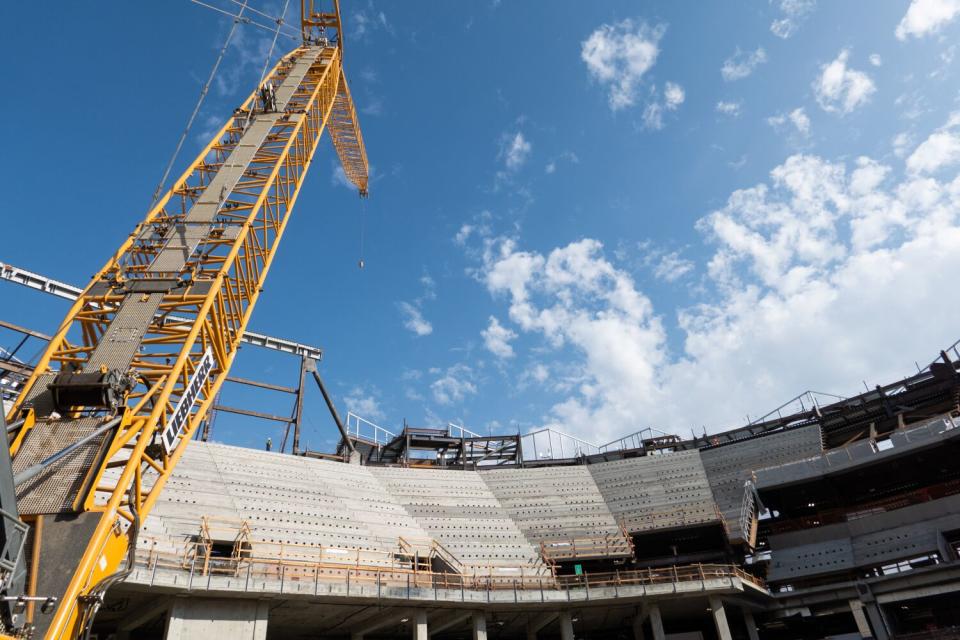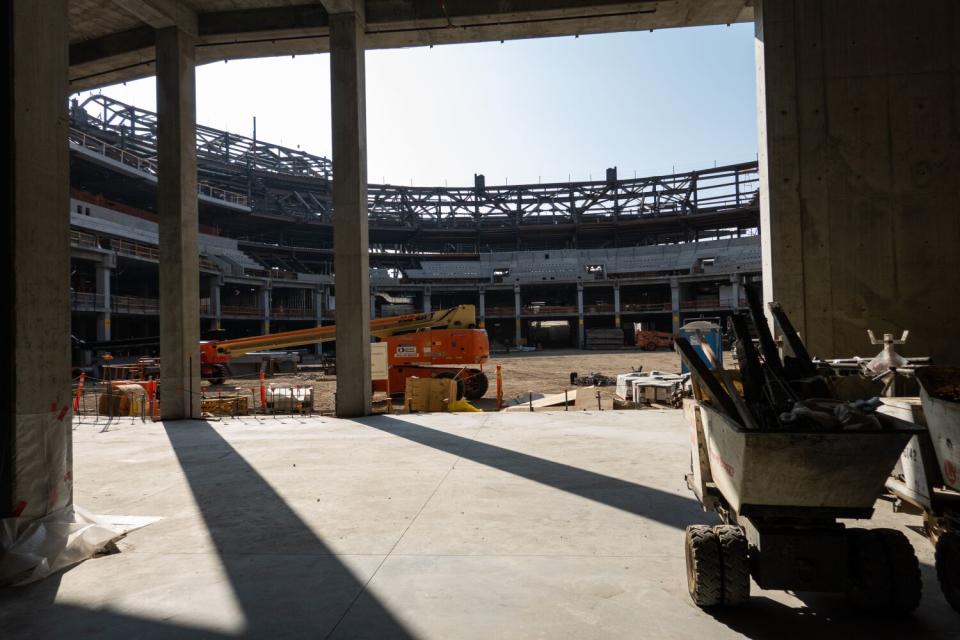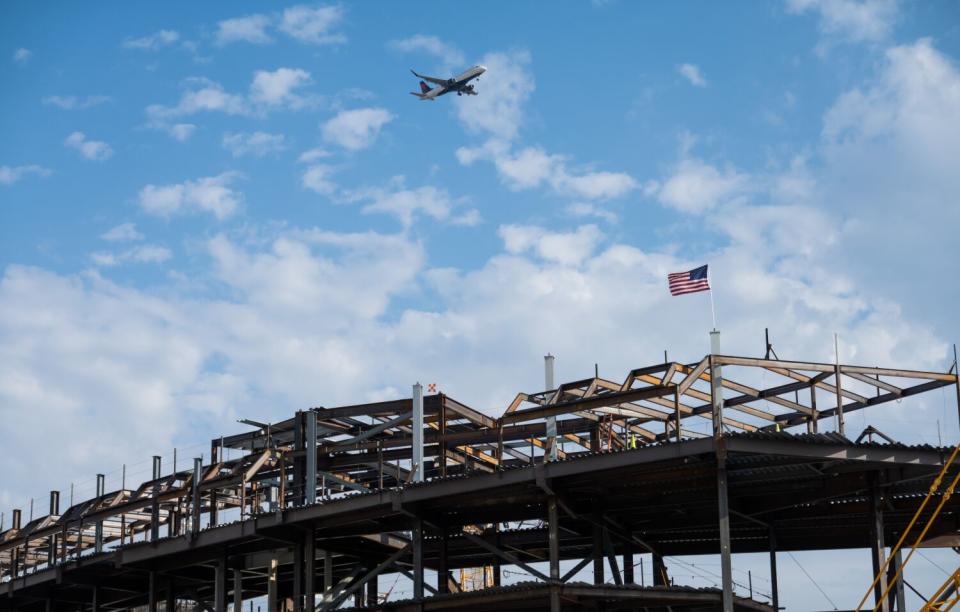Inside super fan Steve Ballmer's construction plans for the perfect NBA arena
- Oops!Something went wrong.Please try again later.
The year was 1973 and the muggy Michigan summer pulsed with Motown hits such as “"Higher Ground” and “Superstition.” At Detroit Country Day School, the football team wheezed its way up a steep slope known simply as “The Hill” on the backside of the leafy campus.
The slog wasn’t a straight race to the top. Instead, the teenagers gradually plodded to the summit by getting into formation and running plays. The loudest among them, the one urging everyone, was right tackle Steve Ballmer, the husky son of a Ford manager. Although he would be too reluctant to deliver his valedictory speech, Ballmer, the future chief executive of Microsoft and owner of the Clippers, didn’t hold back when it came to encouraging his out-of-gas buddies.
“You gotta love it,” he screamed, in what would become a team mantra. “You gotta love it!”
Fast-forward nearly 50 years and Ballmer, wearing a construction helmet and bright yellow safety vest, stood in front of a different hill, a severe concrete incline reaching to the heavens. This will become the “Wall of Sound,” a central feature of the glistening new home in Inglewood he’s building for his NBA team. This section of the Intuit Dome will be an unbroken swath of 51 rows from floor to ceiling, a peak of pandemonium cleverly teetering above the visitors’ bench.

“We want a little more intensity on that side,” said Ballmer, 66, frantically clapping his hands with the unbridled glee of that Country Day kid.
The $2-billion arena, scheduled to open in summer 2024, is located at the intersection of Prairie and Century, across the street from SoFi Stadium. It will feature the main court and four others — three for the Clippers to use for practice, and a fourth for community events. The venue will have 640 restroom stalls, twice as many as its next-closest NBA competitor.
To understand the arena project and what made it what it is — its design, scope, ambition — you have to understand Ballmer. And if you want to truly understand Ballmer — to see what made him who he is and what he wants to achieve — look no further than this arena.
Ballmer, whose passion for the Clippers and basketball, in general, is boundless, wants to do everything he can to change that reputation of the late-arriving, early-departing Los Angeles fan, so all arrows point to keeping them in their seats. That means creating as much convenience as possible — including no-line, grab-and-go concession stands — and finding that ideal balance between intensity and comfort.
“I was tortured by legroom versus how tight to make the bowl,” he said. “Legroom hurts intensity. Because just think about it, it pushes you back to have more legroom. If you want to go steep with legroom, then it’s really tall steps that a lot of people struggle with.”
In the end, Ballmer decided the people at the top of the arena should have the same amount of legroom as the fans who paid more to be closer to the action.

What’s more, from the construction to the day-to-day operation, Ballmer is determined to make the building the most environmentally friendly of its kind.
As he toured the site recently, as he does every few weeks, Ballmer met with the hundreds of construction workers, shaking hands, asking questions, studying renderings on a tablet computer and shooting video on his phone to send to his family.
“Keep driving it hard, man,” he told one group after autographing their Clippers flag, sounding like that high school kid cheering his teammates up The Hill. “You’ve got a lot of work to do.”
This will mark the first time the Clippers will have an arena built specifically for them, and their owner believes that will help them move closer to equal footing with the Lakers.
“Everything’s a step,” said Ballmer, who bought the team in 2014. “It’s one step toward taking our place on the main stage in terms of L.A. basketball. There’s no question, we have zero championships and the other guys in town [have] lots. OK, we’re not going to have lots tomorrow. With luck, we’ll have as many as they do by the time I die — whoops, I’d better live [laughs] probably a few more years.
“We’re going to have to prove to people that we care super much about our fans. We can’t be ambiguous. We have to put on a production that’s more exciting. At the end of the day, what we’ve got to give people is great teams that win championships. There’s no substitute for that.
“But at least in our own building, we’re not playing on the worst nights. If you look at our [Crypto.com Arena] schedule, when it’s `Monday Night Football,’ we play. It’s not when the Lakers or Kings play. It’s the lease — I didn’t sign the lease — but it’s the lease that’s in place.”
Ballmer is quick to point out he’s not an architect or construction expert, nor was he a software designer at Microsoft. But he knows how to carry out a vision.
“I remember when we did our Xbox product,” he said. “Somebody said, 'What would we want the cover of Time magazine to look like?' We did that on the front end of the project to help us get really crisp about what the vision is.”
It was with that spirit that Ballmer and his team of architects and designers traveled all over the world — paying particular attention to college and NBA venues — with the goal of creating an iconic building that caters to the true basketball fan. The idea is to put the game itself front and center, rather than constructing a glitzy gathering place that, by the way, also hosts basketball games.

“It’s almost like you have to see a basketball game at [Duke University's] Cameron Indoor,” Clippers general manager Michael Winger said. “You have to see a baseball game at Wrigley Field. And we want to be one of those places. You have to see a basketball game at the Intuit Dome to see what Steve has done here.”
Sometimes, providing a different experience means leaving out elements that some fans might expect.
“We made some decisions that some people will like, some may not,” Ballmer said. “One of the things people are doing now is having more open social spaces where you can sort of gander at the game and mix with friends. We don’t have any of those. I want people in their seats.”
That means there will be 199 countdown clocks throughout the building to remind fans when a timeout is ending so they won’t miss the action. It also means there will be some type of sensor that detects when fans are in and around their specific seat, possibly with the team rewarding them for that.
“If we know that you’re near your chair — near your chair means you’re probably cheering — maybe we’ll pop you with a reward if we figure out you’re in your chair at a certain time,” Ballmer said.

He and his design team are tinkering with the idea of building directional buttons into the armrests of the chairs — up, down, left, right — so they can conduct polls during a game or crowdsource specific sections for information.
“If fans in a certain area say it’s too hot or too cold, we’ll scan what the fans express and then adjust the temperature based on that,” he said.
Traditionally, technology is pushed to the end of a construction project because those elements are constantly evolving.
“There will be something different with Steve,” said Hall of Famer Jerry West, a Clippers executive. “He will come up with things that will be uniquely different than other owners, because that’s how his mind works.”
Ballmer, whose net worth is estimated in the range of $80 billion to $100 billion, is the wealthiest owner of any American sports franchise. He could build whatever type of arena he wants. But his goal with the Intuit Dome is not to wow people with Jetsons-type technology. He wants to use tech in a purposeful way that creates conveniences and helps maintain the crackling electricity of the experience.
Just as the Rams and Chargers have at SoFi, Ballmer’s arena will feature a halo-type video board suspended from the roof. The Clippers say the 38,375-square-foot 4K display will “feature more replays, more videos and more advanced stats than any scoreboard in the world.”
Lumen Field, home of the Seattle Seahawks, is in the Guinness Book of World Records for having the loudest crowd roar of any outdoor stadium. Ballmer, who once reportedly ripped his vocal cords shouting “Windows! Windows!” at a Microsoft sales meeting, is looking to create the NBA’s version of that.
“We’ve done acoustic models of the building,” he said. “We looked at putting in some panels but it only got us one more decibel under the sound models. It’s of great importance. How low can we bring the ceiling? That gives more intimacy and more of a sense of noise.”
So, while he wants his players to raise the roof, Ballmer also has looked for ways to lower it. It’s all about getting the Clippers fans behind the team in a full-throated way.

“I never played basketball, let alone at the pro level,” he said. “But I can’t imagine it feels good when all the seats are empty at the beginning of the game or beginning of the third quarter. Now that does happen. There’s traffic in L.A. It’s going to happen more in L.A. and all that, but we can do what we can do.”
Ballmer was on scholarship at Detroit Country Day, which cost $2,000 per year when he was a student. His mother, Beatrice, was from Ukraine, and his father, Frederic, was Swiss and in his 20s was an interpreter at the Nuremberg Trials and at the war criminal trials in Dachau, a concentration camp built by Nazi Germany.
“Steve’s dad was fascinating, very bright, intellectual,” said Jerry Hansen, 85, who frequently played golf with the elder Ballmer and was Steve’s high school calculus teacher and junior varsity football coach.
“When you’re teaching and you’ve got these kids in front of you, you don’t know how they’re going to turn out,” Hansen said. “Maybe the kid in the last chair in the class or the first chair, you don’t know if they’re going to be a Supreme Court justice or have a grocery store or whatever. But with Steve, you could tell. You knew right from the get-go that this kid was going to make something of himself. You knew from the work ethic, the energy, the intelligence.”
Long before he was able to buy a sports team, Ballmer got a taste of what was involved in running one. When he was a student at Harvard, he was head manager of the football team, a coveted position that back then was pretty much a golden ticket to Harvard Business School. At one of his reunions, he delivered a speech titled, “Everything I needed to know in business, I learned as a Harvard football manager,” and it was only partly tongue-in-cheek.
“You learn logistics,” he said. “Coach tells you, 'Keep us on schedule. Let me know what’s going on. Keep the players moving. Plan the buses. Make sure the hotels, the meals, everything’s in good shape.'"

Although Ballmer earned $12 per game keeping stats for the Harvard basketball team, his football gig was unpaid. Not surprisingly, he attacked both jobs with gusto.
Recalled Steve Kaseta, a defensive end and captain on that 1976 Harvard team: “Steve was so good at the job. Part of his skillset is the ability to multitask and have a really good sense of all of these moving parts.”
One of those moving parts was Ballmer’s trembling voice, which fluttered like the butterflies in his stomach when he first stood to address the players.
“I remember the first time doing it my voice cracked,” he said. “You’d get out there, and the manager’s not exactly what you’d call the most respected guy. 'HeY eVeryBody, LiSteN uP…' My voice is just cracking.”
Years later, when he was at Microsoft, Ballmer came up with an interesting method of staying on track in his speeches.
“I would write my first two or three bullet points on the back of my hand,” he said. “I don’t think I ever looked at them. It was like comfort food.”
He still does that for talks that aren’t off the cuff, giving new meaning to the idea of knowing a subject like the back of your hand.
At Detroit Country Day, Ballmer had been named valedictorian but, because he wasn’t keen on making public speeches, asked that the honor be given to his more loquacious buddy, Bryan Schefman.
“I don’t know if he was shy or just didn’t want the limelight, but he definitely didn’t want to stand up in front of everyone and give a speech,” said Schefman, now a lawyer in Bloomfield Hills, Mich. “I was very excited and extremely grateful. But Steve didn’t want to stand out. He wanted all of us to be together, and we were a very tight class.”
Ballmer and Schefman formed the right side of the football team’s offensive line and joked with each other about who would reach 300 pounds first. Schefman, a pulling guard, weighed about 190 and estimates Ballmer was 30 pounds heavier. But they happily filled their bellies with that ultimate goal in mind.
Hansen understood how to push his players' buttons.
“I remember one halftime and we were losing to a bigger team but not a better team,” Schefman said. “And Mr. Hansen said the ultimate insult to all of us: `You kids are playing like a bunch of rich kids.’ That irked us. We went out and slaughtered them.”
Hansen still has Ballmer’s ear. The two play golf together in Michigan when they get a chance. And the longtime teacher weighed in on what became an important element of the arena.

Said Ballmer: “He kept saying to me, 'Don’t forget the little guys! Don’t forget the guys in the upper bowl!' … So I had to make sure the upper bowl was good. We really wanted to say, `Hey, you may not be able to sit as close to the court, but that doesn’t mean you have to be uncomfortable. Normally people cram up there. We’ll have the same-sized seats.”
Ballmer wants his arena to be basketball’s answer to Camden Yards or Lambeau Field. A bucket-list item for bucket lovers.
This story originally appeared in Los Angeles Times.

